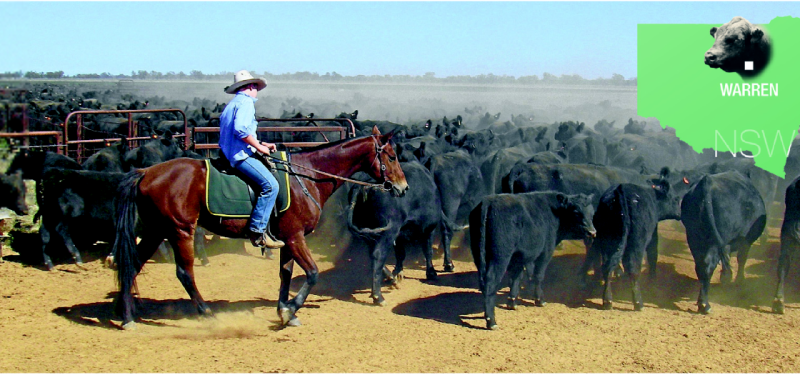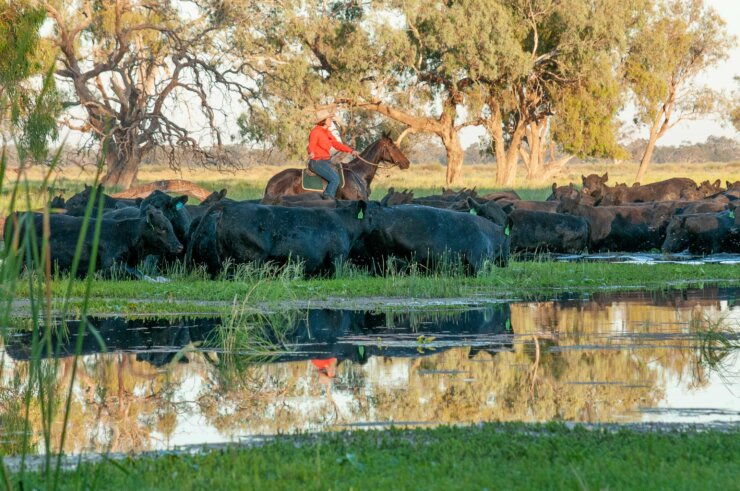
MUSTERING IN THE MARSHES
MANDY McKESSICK, Australian Farmers, September 19 2024.
The Macquarie Marshes, 240km north-west of Dubbo in northern NSW, are listed by the Ramsar Convention as Wetlands of International Importance, being one of the most critical nesting grounds for Australian waterbirds. Over 500,000 birds, including the threatened Australasian Bittern and Australasian Painted Snipe, can be found here in a good season when the air rings with a cacophony of calls.
Best of both worlds
The Marshes are also home to Garry and Leanne Hall who run 800 Angus breeding cows, supplying steers to domestic and export markets, on their 6400ha property The Mole. It may seem contradictory to have a commercial farming operation in such a sensitive environment, but the Halls are inextricably tied to the health of the wetlands and are, perhaps, their biggest advocate. As Garry says: “Fat ducks equal fat cattle”.
Mustering on The Mole is a wet business as horses and cattle plunge through head-high reed-beds as endangered bird species wing overhead. Children Jet (19) and Teague (22), who represent the fifth generation of Halls here, are often on-hand saddling one of 20 horses that the property breeds.
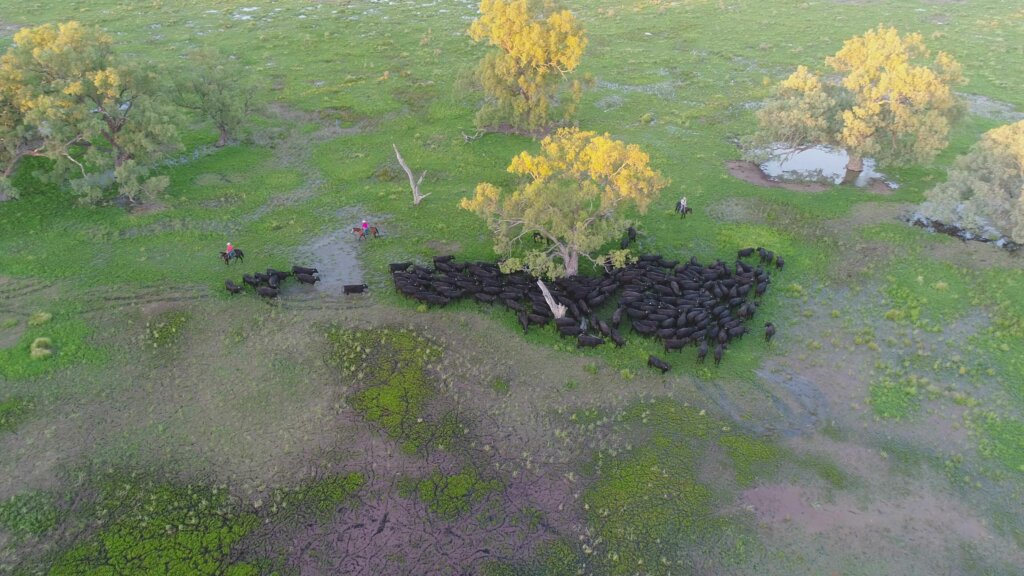
Beef’s Hall of Fame
The way they manage their Angus cattle, and how many breeders they join, is heavily reliant on water availability and environmental flows held in upstream Burrendong Dam.
The Halls’ focus is on producing Angus cattle with good meat eating quality on their 5250ha property, The Mole, 114km north of Warren in the NSW Central West.
“Our main breeding country is in the Macquarie Marshes so water impacts our production system greatly,” Garry said.
Similar to an irrigation crop farmer, their management and production is influenced by environmental releases and tributary flows that provide beneficial flooding.
“It dictates the number of cows we join, the number of calves we hang on to, but it’s no different to an irrigator and we can budget on the available water,” Garry said.
“Water is the key driver of the ecosystem function of the wetland. All grasses that grow here are frost sensitive and they dry off in winter, so they require inundation in the spring,” Garry said. “It is a complex grazing system.”
The Hall family has owned The Mole since 1934 and Garry said they continued to work with the environment and were constantly adapting to a changing environment.
For the past 26 years they have run Angus cattle, currently joining between 700 and 900 females, working on the premise that the optimum number of calves is 720.
Users of genetics from the Te Mania Angus stud at Mortlake for the past 15 years, the Halls joined the Team Te Mania program in 2009.
TEAM EFFORT
TEAM Te Mania is a partnership between beef cattle producers and Te Mania, allowing members access to the latest genetics through a bull leasing program and discounted artificial insemination.
It also provides team members the ability to collectively market their cattle under the Team Te Mania brand with production feedback provided back to Te Mania to provide valuable genetic information.
Garry said being part of Team Te Mania and leasing the bulls meant they received access to genetics they otherwise probably couldn’t afford.
“Bulls are true to type and they are selected to suit our breeding objectives, we then provide our slaughter data back to Te Mania so we can then continue to improve on the objectives,” he said.
Artificial insemination is also used, with between 200 and 300 joined with fixed-time AI each year, depending on the season.
Garry said being part of the team meant they were always one step ahead on genetic gain.
“I like the excitement of being involved in those new sires early in their breeding careers,” he said.
Cows and 15-month-old heifers are joined in October to calve in July-August.
“Females are run in the Marsh country and the pasture is high in protein for a short period in spring and summer, so when the calves hit the ground the feed quality is good,” Garry said.
NORTHERN EXPOSURE
CALVES are weaned at about six months, depending on feed availability, for seven to 10 days.
“They are restricted in a small yard for two to three days, then moved to a holding paddock so they get used to being handled by people, dogs and horses,” Garry said.
“It gives them exposure to different things so they know how to be educated for the rest of their life.”
Garry and Leanne also use horses and dogs for handling stock.
“Using horses on cattle in the Marshes works well and it means we can retain all of our senses,” Leanne said.
The Halls aim to breed steers for the export feedlot market because it suits their production system.
The steers are grazed on forage crops of barley, oats or wheat from when they are 230-250kg weaners and grown to 400-500kg, when they are sold to feedlots.
The heifer progeny is assessed and either kept as future breeders, culled, or sold through Team Te Mania avenues.
Fertility and longevity were two key breeding objectives.
“Females have to rear a calf every year. It is no good having animals on the place which aren’t productive,” Garry said.
The Halls have a long history of pregnancy-testing and any females not in calf or that come in at branding without a calf are culled.
“The real criminals in our system are those females who are tested in calf, then come in at branding without a calf, they have gone 12 months without any increase in value.”
SHORT STOP
GARRY said they liked selecting for a short gestation length, which helps with calving ease because the calf is smaller and heifers have longer to recover before getting back in calf.
Meat-eating quality is also important to the Halls.
“We are food producers. If we want to achieve a premium we have to produce a high-quality product,” Garry said.
“We choose moderate carcass traits, but we still want them to perform above average for eating quality, so it is about finding the balance.”
Garry said they were not only conscious of improving the quality of their cattle, but also the quality of the landscape, soil and ecosystem.
Part of their property is Ramsar listed — this is a List of Wetlands of International Importance as defined by the Ramsar Convention.
“We are grazing in an environmentally sensitive area so we are conscious of the impact on the environment and we are extremely aware of our social licence.”
“In our grazing system the main principle of it is not to stock it too highly while it is wet.”
While they don’t “rotational graze” as such, Garry said they do include a rest period in paddocks at optimal time of plant growth.
“We’ve got a particular type of pasture which needs to store energy in autumn, so we try to include a rest period.”
The Mole has an average annual rainfall of 400mm.
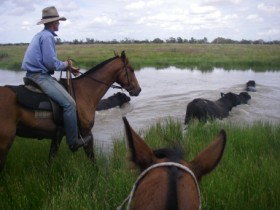 Hall Garry Getting The Bulls In 2 280 X 210
Hall Garry Getting The Bulls In 2 280 X 210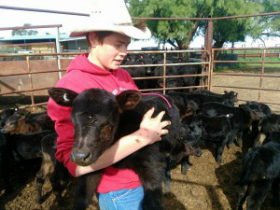
 Photos by Leanne Hall
Photos by Leanne Hall Rangers Vallley Porterhouse Richard Eldershaw, Hamish (TMA), Garry Hall
Rangers Vallley Porterhouse Richard Eldershaw, Hamish (TMA), Garry Hall
- Team Te Mania Member since 2010
Fat Ducks, Fat Cattle by Mandy McKeesick, RM Williams Outback, Feb/March 2021
Macquarie Marshes come back to life after drought and fire by Lucy Thackray, ABC News , October 17, 2020
Optimising Fertility at The Mole, By Rebecca Sharpe and Stephen Burns, The Land August 2015
Objectives in Focus at Warren By Natalie Elias, The Land, January 2011
